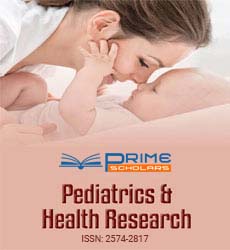Perspective - (2023) Volume 8, Issue 2
Navigating Pediatric Asthma: Understanding, Managing, and Empowering Young Lives
Susan Julie*
Department of Children Sciences, Wageningen University, Netherlands
*Correspondence:
Susan Julie,
Department of Children Sciences, Wageningen University,
Netherlands,
Email:
Received: 31-May-2023, Manuscript No. IPPHR-23-17244;
Editor assigned: 02-Jun-2023, Pre QC No. IPPHR-23-17244 (PQ);
Reviewed: 16-Jun-2023, QC No. IPPHR-23-17244;
Revised: 21-Jun-2023, Manuscript No. IPPHR-23-17244 (R);
Published:
28-Jun-2023, DOI: 10.36648/2574-2817-8.2.15
Introduction
Pediatric asthma is a chronic respiratory condition that affects
millions of children worldwide. As a leading cause of hospitalizations
and school absenteeism, asthma presents a significant
challenge to children’s health and well-being. This article aims
to shed light on the complexities of pediatric asthma, including
its causes, symptoms, diagnosis, treatment, and strategies
for managing the condition effectively. Asthma is a chronic inflammatory
disorder of the airways, characterized by episodes
of wheezing, breathlessness, chest tightness, and coughing. In
pediatric cases, these symptoms can be particularly distressing
and disruptive to daily life. The airways of children with asthma
are hypersensitive to various triggers, such as allergens, respiratory
infections, exercise, and cold air. When exposed to these
triggers, the airways become inflamed and narrow, leading
to the classic symptoms. The exact cause of asthma remains
unclear, but it is believed to result from a combination of genetic
predisposition and environmental factors. Children with
a family history of asthma or allergies are at a higher risk of developing
the condition. Additionally, exposure to secondhand
smoke during early childhood, respiratory infections, and living
in environments with poor air quality can increase the likelihood
of asthma development. Pediatric asthma symptoms can
vary widely and may even change over time. Infants and young
children often exhibit symptoms such as recurrent coughing
(especially at night), rapid breathing, and wheezing.
Description
Pediatric asthma management is a collaborative effort involving
healthcare professionals, caregivers, and the child. Key components
of effective management include: Two types of medications
are commonly used for asthma-quick-relief (rescue)
and long-term control (maintenance) medications. Quick-relief
medications provide immediate relief during asthma attacks,
while long-term control medications help prevent symptoms
and reduce inflammation. A personalized asthma action plan
outlines how to manage the child’s asthma on a day-to-day
basis and during exacerbations. It includes medication schedules,
triggers to avoid, and steps to take in case of worsening
symptoms. Identifying and avoiding triggers that exacerbate
asthma symptoms is crucial. These triggers can include allergens
like pollen and pet dander, as well as irritants like tobacco
smoke. Empowering children and their caregivers with knowledge
about asthma is essential. Understanding the condition,
its triggers, and the proper use of medications promotes better
self-management and adherence to treatment plans.
Regular visits to healthcare professionals allow for assessment
of asthma control, adjustments to treatment plans, and monitoring
of lung function.
Conclusion
Pediatric asthma can have a significant impact on a child’s quality
of life. Frequent asthma symptoms can limit physical activities,
sports participation, and social interactions. Moreover,
poorly managed asthma can lead to school absenteeism and
hinder academic performance. Children with asthma might
also experience emotional challenges due to the constraints
imposed by the condition. The emotional well-being of children
with asthma is as important as their physical health. The
anxiety and stress associated with asthma symptoms can be
alleviated through open communication between caregivers,
children, and healthcare professionals. Providing a supportive
environment and encouraging children to express their feelings
can help reduce the emotional burden of the condition.
Schools and communities play an essential role in supporting
children with asthma. Educators should be aware of students
with asthma and their individual needs, ensuring that emergency
medication is accessible and that students can engage in
physical activities safely.
Citation: Julie S (2023) Navigating Pediatric Asthma: Understanding, Managing, and Empowering Young Lives. Pediatr Heal Res.
8:15.
Copyright: © 2023 Julie S. This is an open-access article distributed under the terms of the Creative Commons Attribution License,
which permits unrestricted use, distribution, and reproduction in any medium, provided the original author and source
are credited.
